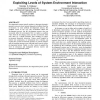Free Online Productivity Tools
i2Speak
i2Symbol
i2OCR
iTex2Img
iWeb2Print
iWeb2Shot
i2Type
iPdf2Split
iPdf2Merge
i2Bopomofo
i2Arabic
i2Style
i2Image
i2PDF
iLatex2Rtf
Sci2ools
GECCO
2007
Springer
2007
Springer
Dynamical blueprints: exploiting levels of system-environment interaction
Developmental systems typically produce a phenotype through a generative process whose outcome depends on feedback from the environment. In most artificial developmental systems, this feedback occurs in one way: The environment affects the development process, but the development process does not necessarily affect the environment. Here we explore a condition where both the developing system and the environment affect each other on a similar timescale, thus resulting in systemenvironment dynamical interaction. Using a model inspired by termite nest construction, we demonstrate how evolution can exploit these system-environment dynamics to generate adaptive and self-repairing structure more efficiently than a purely reactive developmental system. Finally, we offer a metric to quantify the level of interaction and distinguish between reactive and interactive developmental systems. Categories and Subject Descriptors I.2.2 [Artificial Intelligence]: Automatic Programming General Terms Alg...
Related Content
| Added | 07 Jun 2010 |
| Updated | 07 Jun 2010 |
| Type | Conference |
| Year | 2007 |
| Where | GECCO |
| Authors | Nicolás S. Estévez, Hod Lipson |
Comments (0)

